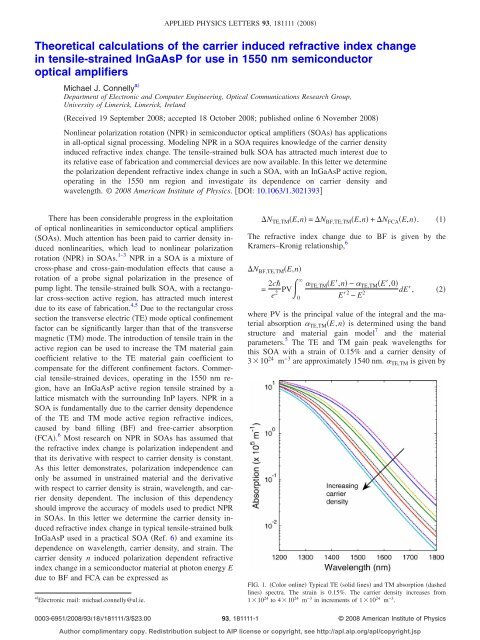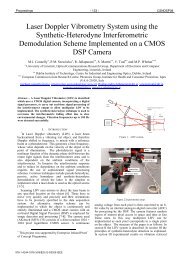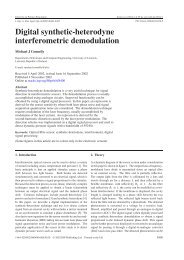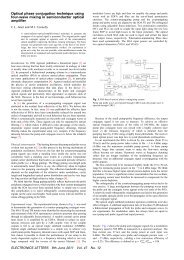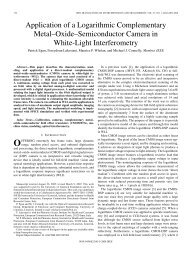Theoretical calculations of the carrier induced refractive index ...
Theoretical calculations of the carrier induced refractive index ...
Theoretical calculations of the carrier induced refractive index ...
Create successful ePaper yourself
Turn your PDF publications into a flip-book with our unique Google optimized e-Paper software.
APPLIED PHYSICS LETTERS 93, 181111 2008<br />
<strong>Theoretical</strong> <strong>calculations</strong> <strong>of</strong> <strong>the</strong> <strong>carrier</strong> <strong>induced</strong> <strong>refractive</strong> <strong>index</strong> change<br />
in tensile-strained InGaAsP for use in 1550 nm semiconductor<br />
optical amplifiers<br />
Michael J. Connelly a<br />
Department <strong>of</strong> Electronic and Computer Engineering, Optical Communications Research Group,<br />
University <strong>of</strong> Limerick, Limerick, Ireland<br />
Received 19 September 2008; accepted 18 October 2008; published online 6 November 2008<br />
Nonlinear polarization rotation NPR in semiconductor optical amplifiers SOAs has applications<br />
in all-optical signal processing. Modeling NPR in a SOA requires knowledge <strong>of</strong> <strong>the</strong> <strong>carrier</strong> density<br />
<strong>induced</strong> <strong>refractive</strong> <strong>index</strong> change. The tensile-strained bulk SOA has attracted much interest due to<br />
its relative ease <strong>of</strong> fabrication and commercial devices are now available. In this letter we determine<br />
<strong>the</strong> polarization dependent <strong>refractive</strong> <strong>index</strong> change in such a SOA, with an InGaAsP active region,<br />
operating in <strong>the</strong> 1550 nm region and investigate its dependence on <strong>carrier</strong> density and<br />
wavelength. © 2008 American Institute <strong>of</strong> Physics. DOI: 10.1063/1.3021393<br />
There has been considerable progress in <strong>the</strong> exploitation<br />
<strong>of</strong> optical nonlinearities in semiconductor optical amplifiers<br />
SOAs. Much attention has been paid to <strong>carrier</strong> density <strong>induced</strong><br />
nonlinearities, which lead to nonlinear polarization<br />
rotation NPR in SOAs. 1–3 NPR in a SOA is a mixture <strong>of</strong><br />
cross-phase and cross-gain-modulation effects that cause a<br />
rotation <strong>of</strong> a probe signal polarization in <strong>the</strong> presence <strong>of</strong><br />
pump light. The tensile-strained bulk SOA, with a rectangular<br />
cross-section active region, has attracted much interest<br />
due to its ease <strong>of</strong> fabrication. 4,5 Due to <strong>the</strong> rectangular cross<br />
section <strong>the</strong> transverse electric TE mode optical confinement<br />
factor can be significantly larger than that <strong>of</strong> <strong>the</strong> transverse<br />
magnetic TM mode. The introduction <strong>of</strong> tensile train in <strong>the</strong><br />
active region can be used to increase <strong>the</strong> TM material gain<br />
coefficient relative to <strong>the</strong> TE material gain coefficient to<br />
compensate for <strong>the</strong> different confinement factors. Commercial<br />
tensile-strained devices, operating in <strong>the</strong> 1550 nm region,<br />
have an InGaAsP active region tensile strained by a<br />
lattice mismatch with <strong>the</strong> surrounding InP layers. NPR in a<br />
SOA is fundamentally due to <strong>the</strong> <strong>carrier</strong> density dependence<br />
<strong>of</strong> <strong>the</strong> TE and TM mode active region <strong>refractive</strong> indices,<br />
caused by band filling BF and free-<strong>carrier</strong> absorption<br />
FCA. 6 Most research on NPR in SOAs has assumed that<br />
<strong>the</strong> <strong>refractive</strong> <strong>index</strong> change is polarization independent and<br />
that its derivative with respect to <strong>carrier</strong> density is constant.<br />
As this letter demonstrates, polarization independence can<br />
only be assumed in unstrained material and <strong>the</strong> derivative<br />
with respect to <strong>carrier</strong> density is strain, wavelength, and <strong>carrier</strong><br />
density dependent. The inclusion <strong>of</strong> this dependency<br />
should improve <strong>the</strong> accuracy <strong>of</strong> models used to predict NPR<br />
in SOAs. In this letter we determine <strong>the</strong> <strong>carrier</strong> density <strong>induced</strong><br />
<strong>refractive</strong> <strong>index</strong> change in typical tensile-strained bulk<br />
InGaAsP used in a practical SOA Ref. 6 and examine its<br />
dependence on wavelength, <strong>carrier</strong> density, and strain. The<br />
<strong>carrier</strong> density n <strong>induced</strong> polarization dependent <strong>refractive</strong><br />
<strong>index</strong> change in a semiconductor material at photon energy E<br />
due to BF and FCA can be expressed as<br />
a Electronic mail: michael.connelly@ul.ie.<br />
N TE,TM E,n = N BF,TE,TM E,n + N FCA E,n.<br />
The <strong>refractive</strong> <strong>index</strong> change due to BF is given by <strong>the</strong><br />
Kramers–Kronig relationship, 6<br />
N BF,TE,TM E,n<br />
= 2c e 2 PV TE,TM E,n − TE,TM E,0<br />
0 E 2 − E 2 dE, 2<br />
where PV is <strong>the</strong> principal value <strong>of</strong> <strong>the</strong> integral and <strong>the</strong> material<br />
absorption TE,TM E,n is determined using <strong>the</strong> band<br />
structure and material gain model 7 and <strong>the</strong> material<br />
parameters. 5 The TE and TM gain peak wavelengths for<br />
this SOA with a strain <strong>of</strong> 0.15% and a <strong>carrier</strong> density <strong>of</strong><br />
310 24 m −3 are approximately 1540 nm. TE,TM is given by<br />
FIG. 1. Color online Typical TE solid lines and TM absorption dashed<br />
lines spectra. The strain is 0.15%. The <strong>carrier</strong> density increases from<br />
110 24 to 410 24 m −3 in increments <strong>of</strong> 110 24 m −3 .<br />
1<br />
0003-6951/2008/9318/181111/3/$23.00<br />
93, 181111-1<br />
© 2008 American Institute <strong>of</strong> Physics<br />
Author complimentary copy. Redistribution subject to AIP license or copyright, see http://apl.aip.org/apl/copyright.jsp
181111-2 Michael J. Connelly Appl. Phys. Lett. 93, 181111 2008<br />
FIG. 2. Color online FCA <strong>induced</strong> <strong>refractive</strong> <strong>index</strong> change at 1550 nm for<br />
a strain <strong>of</strong> 0.15%. The parabolic approximation uses effective masses for<br />
unstrained InGaAsP.<br />
FIG. 4. Color online BF and FCA contributions to <strong>the</strong> <strong>refractive</strong> <strong>index</strong><br />
change vs wavelength for no strain. The <strong>carrier</strong> density increases from<br />
110 24 to 410 24 m −3 in increments <strong>of</strong> 110 24 m −3 in <strong>the</strong> direction <strong>of</strong><br />
<strong>the</strong> arrows. There is no polarization dependence.<br />
TE,TM E,n = C g<br />
E<br />
<br />
b=LH,HH,SO0<br />
<br />
0<br />
<br />
k 2 sin M TE,TM,b k, 2<br />
LE cv,b k,1−f c kf v,b k,d dk, 3<br />
where “LH,” “HH,” and “SO” denote <strong>the</strong> light-hole, heavyhole,<br />
and split-<strong>of</strong>f valence bands VBs respectively, C g<br />
=e 2 /2 0 cm 2 0 N r , N r is <strong>the</strong> <strong>refractive</strong> <strong>index</strong> with no injected<br />
<strong>carrier</strong>s, M TE,TM,b k, are <strong>the</strong> matrix elements, and<br />
E cv,b k, are <strong>the</strong> conduction band CB to VB transition<br />
energies. k and are <strong>the</strong> magnitude and azimuth <strong>of</strong> <strong>the</strong> momentum<br />
vector. 7 Intraband relaxation and doping effects are<br />
taken into account using a sech line broadening function<br />
LE cv,b = r / sech⌊ r /E cv,b −⌋, where r <strong>the</strong> effective<br />
intraband relaxation time is taken to be 22.4 fs. 5 The absorption<br />
spectrum <strong>calculations</strong> take into account band-gap<br />
shrinkage. Calculated absorption spectra for a strain <strong>of</strong><br />
0.15% are shown in Fig. 1. Using Eq. 2 N BF,TE,TM can be<br />
FIG. 3. Color online BF and FCA contributions to <strong>the</strong> <strong>refractive</strong> <strong>index</strong><br />
change at 1550 nm as a function <strong>of</strong> <strong>carrier</strong> density. The strain varies from<br />
0% to 0.2% in increments <strong>of</strong> 0.05%.<br />
FIG. 5. Color online BF and FCA contributions to <strong>the</strong> <strong>refractive</strong> <strong>index</strong><br />
change as a function <strong>of</strong> wavelength, with <strong>the</strong> <strong>carrier</strong> density as parameter,<br />
for a tensile strain <strong>of</strong> 0.15%. The <strong>carrier</strong> density increases from 110 24 to<br />
410 24 m −3 in increments <strong>of</strong> 110 24 m −3 in <strong>the</strong> direction <strong>of</strong> <strong>the</strong> arrows.<br />
The solid and dotted lines <strong>of</strong> <strong>the</strong> BF contribution refer to TE and TM<br />
polarizations, respectively.<br />
Author complimentary copy. Redistribution subject to AIP license or copyright, see http://apl.aip.org/apl/copyright.jsp
181111-3 Michael J. Connelly Appl. Phys. Lett. 93, 181111 2008<br />
determined as a function <strong>of</strong> wavelength, <strong>carrier</strong> density, and<br />
strain. The <strong>refractive</strong> <strong>index</strong> change due to FCA is usually<br />
given as<br />
2 N FCA E,n =− e2 2 n + p 4<br />
2N r 0 E m c m v,<br />
where parabolic bands are assumed. m c and m v are <strong>the</strong> effective<br />
masses <strong>of</strong> <strong>the</strong> CB and VB heavy-hole, respectively. p<br />
is <strong>the</strong> VB hole density. In general, <strong>the</strong> CB can deviate from<br />
being parabolic. Fur<strong>the</strong>rmore in tensile-strained material, <strong>the</strong><br />
light-hole band is raised above <strong>the</strong> heavy-hole band and can<br />
contribute significantly to <strong>the</strong> FCA <strong>refractive</strong> <strong>index</strong> change.<br />
The VB effective masses are not constant but can vary significantly<br />
with momentum. Generalizing from Eq. 4, <strong>the</strong><br />
CB contribution to N FCA is given by<br />
N FCA,c E,n =− e2 2<br />
2N r 0 E 2 0<br />
<br />
k 2<br />
2 m c k f cE c kdk,<br />
where E c is <strong>the</strong> CB energy-momentum relationship. 5 m c k is<br />
<strong>the</strong> k-dependent effective mass obtained using a parabolic fit<br />
to E c k in a small region around k. k 2 / 2 m c k is <strong>the</strong> density<br />
<strong>of</strong> states and f c is <strong>the</strong> Fermi–Dirac distribution function.<br />
Similarly <strong>the</strong> VB contribution to N FCA is given by<br />
N FCA,v E,n =− e2 2<br />
<br />
k<br />
2N r 0<br />
<br />
2 sin <br />
E 2<br />
b=HH,LH0<br />
dk0 2 2 m v k,<br />
f v E v,b k,d.<br />
6<br />
It is assumed that p=n, as is usually <strong>the</strong> case in SOAs.<br />
E v,b k, is <strong>the</strong> VB energy-momentum relationship and<br />
5<br />
m v k, is <strong>the</strong> k and dependent effective mass obtained<br />
using a parabolic fit to E v,b k, in a small region around k<br />
for a given . Equation 4 can be rewritten as<br />
N FCA E,n = N FCA,c E,n + N FCA,v E,n. 7<br />
A typical <strong>carrier</strong> density dependence <strong>of</strong> N FCA showing<br />
<strong>the</strong> CB and VB contributions and comparison with <strong>the</strong> parabolic<br />
approximation is shown in Fig. 2. The BF and FCA<br />
contributions to <strong>the</strong> <strong>refractive</strong> <strong>index</strong> change at 1550 nm are<br />
shown in Fig. 3 as a function <strong>of</strong> <strong>carrier</strong> density with strain as<br />
parameter. The FCA component is effectively independent <strong>of</strong><br />
<strong>the</strong> strain. However, <strong>the</strong> BF contribution does have significant<br />
polarization dependence. The BF and FCA contributions<br />
to <strong>the</strong> <strong>refractive</strong> <strong>index</strong> change as a function <strong>of</strong> wavelength,<br />
with <strong>the</strong> <strong>carrier</strong> density as parameter for strains <strong>of</strong> 0% and<br />
0.15%, are shown in Figs. 4 and 5, respectively. The <strong>refractive</strong><br />
<strong>index</strong> change has a significant wavelength dependency<br />
and when strain is present significant polarization dependency.<br />
1 H. Soto, D. Erasme, and G. Guekos, IEEE Photon. Technol. Lett. 11, 970<br />
1999.<br />
2 L. Q. Guo and M. J. Connelly, J. Lightwave Technol. 23, 4037 2005.<br />
3 L. Q. Guo and M. J. Connelly, J. Lightwave Technol. 25, 4102007.<br />
4 C. Michie, A. E. Kelly, J. McGeough, I. Armstrong, and I. Andonovic, J.<br />
Lightwave Technol. 24, 3920 2006.<br />
5 M. J. Connelly, IEEE J. Quantum Electron. 43, 472007.<br />
6 P. K. Basu, Theory <strong>of</strong> Optical Processes in Semiconductors Oxford University<br />
Press, New York, 1997.<br />
7 G. Jones and E. P. O’Reilly, IEEE J. Quantum Electron. 29, 1344 1993.<br />
Author complimentary copy. Redistribution subject to AIP license or copyright, see http://apl.aip.org/apl/copyright.jsp


